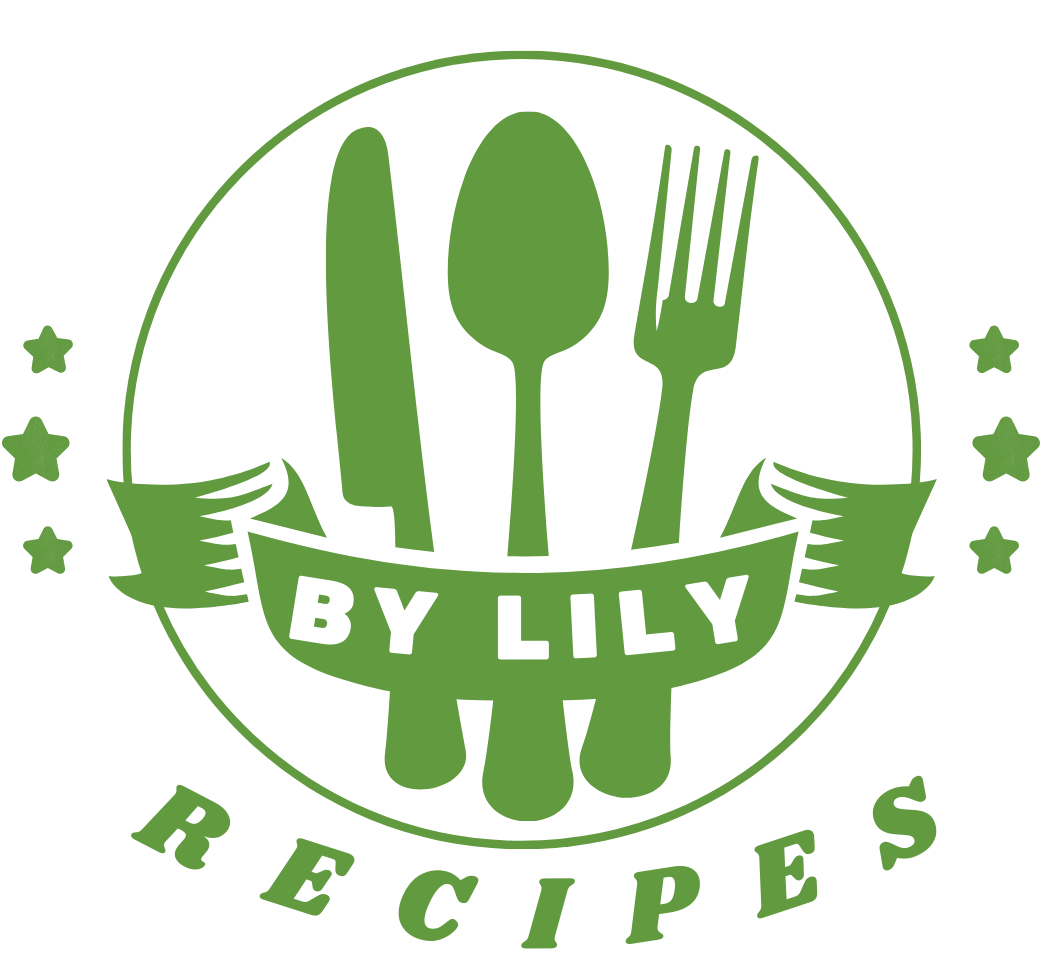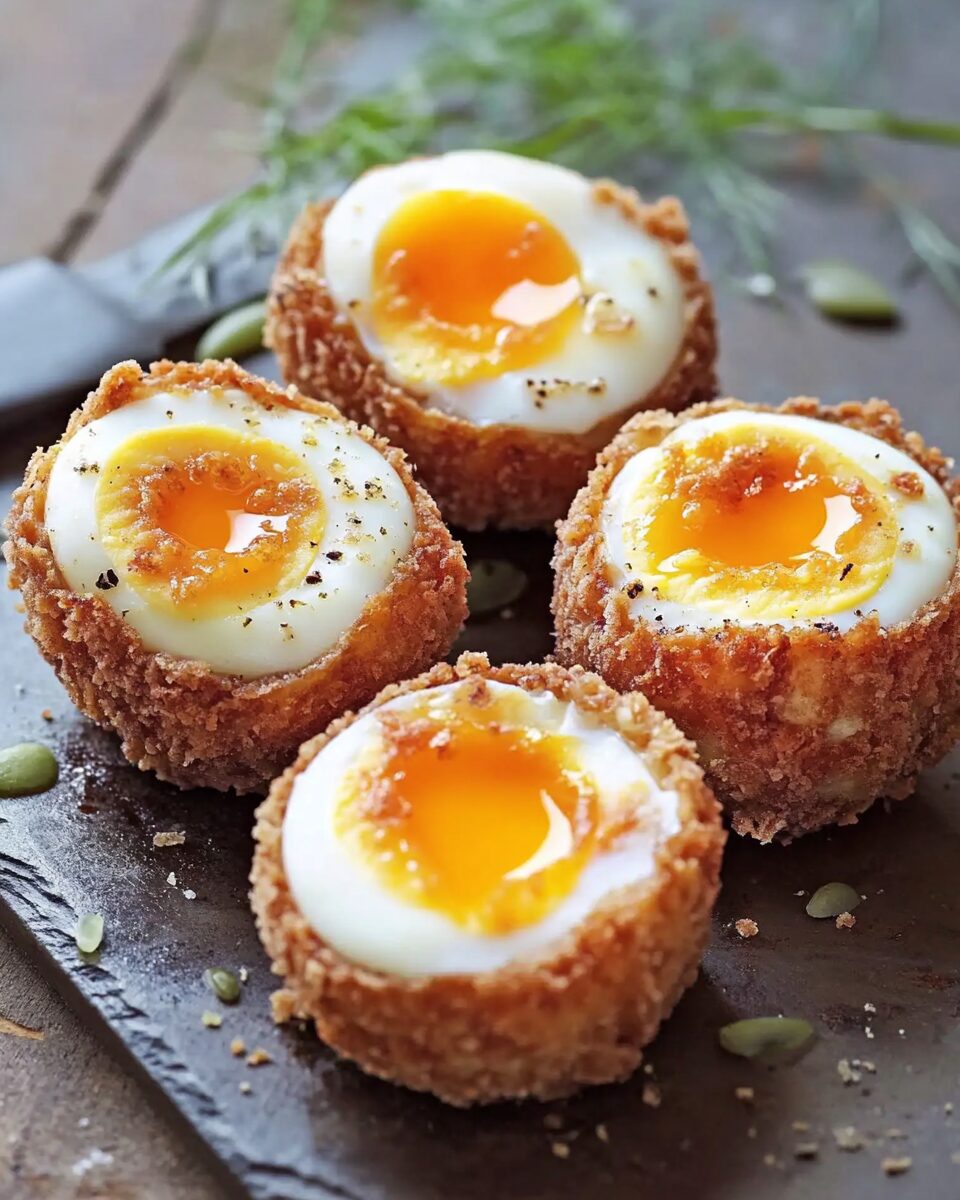Scotch eggs are a classic British dish, traditionally made with hard-boiled eggs wrapped in sausage meat, then crumbed and deep-fried. However, this recipe takes it up a notch by including runny yolks. The challenge is getting the timing just right for both the soft-boiled eggs and the deep-frying process to achieve a perfect crispy outside with a beautifully oozing yolk inside. It might seem daunting, but with the right tips and tricks, you’ll impress your family and friends with these delicious, crispy scotch eggs!
Full Recipe:
Ingredients
- 7 eggs (5 for boiling, 2 for egg wash)
- ½ cup fresh parsley
- 2 stalks spring onion
- 1 sprig thyme (leaves only)
- 500g pork sausages
- 2 tbsp plain white flour
- 1.5 cups panko breadcrumbs
- Vegetable oil (for deep frying)
For the Sour Cream and Horseradish Sauce:
- 4 tbsp sour cream
- 1 tbsp horseradish
Directions
-
Place five eggs in a saucepan and cover them with cold water. Bring to a boil over high heat, then reduce to medium and simmer for 3.5 minutes. While boiling, prepare an ice bath. Once the eggs are done, crack the shells slightly and place them into the ice bath.
-
Finely slice the parsley, spring onion, and remove the thyme leaves. Add them to a bowl.
-
Squeeze the sausage meat from its casing and add it to the herb mixture. Mix together with cold, wet hands. Divide the mixture into five equal portions and roll them into flat discs.
-
In separate bowls, place the flour, remaining two eggs (beaten), and breadcrumbs.
-
Peel the eggs under cold running water, then dust them with flour.
-
Heat vegetable oil in a deep frying pan to halfway up the eggs. Once the oil is hot, wrap each egg with the sausage mixture, ensuring it’s fully enclosed. Dip into the egg wash, then coat with breadcrumbs.
-
Fry the scotch eggs in batches for 8.5 minutes, turning regularly. Once cooked, drain them on crumpled paper towels.
-
For the sauce, mix sour cream and horseradish in a small bowl.
-
Cut the scotch eggs in halves or quarters and serve with the sour cream and horseradish sauce.
Nutrients
- Calories: 504 kcal
- Carbohydrates: 18g
- Protein: 27g
- Fat: 35g
- Saturated Fat: 12g
- Cholesterol: 306mg
- Sodium: 890mg
- Potassium: 534mg
- Fiber: 2g
- Sugar: 2g
- Vitamin A: 2508IU
- Vitamin C: 34mg
- Calcium: 123mg
- Iron: 5mg
The Origins of Scotch Eggs
The history of Scotch eggs dates back to the 18th century, believed to have been invented by Fortnum & Mason, a renowned department store in London. The store is often credited with creating this iconic British snack as a portable, easy-to-eat meal for picnics or travel. Originally, Scotch eggs were made using hard-boiled eggs to ensure they could withstand the journey. Over time, the dish evolved and became a staple at pubs, fairs, and family gatherings across the UK.
The name “Scotch” may come from the old term for “to chop” or “to mince” (as in “Scotch mist” or “Scotch broth”), referring to the sausage meat used to encase the egg. Alternatively, it may simply refer to the Scottish influence on the dish, though its true origin remains a bit of a mystery.
The Evolution of the Classic Scotch Egg
While the classic Scotch egg recipe calls for a hard-boiled egg, many modern versions opt for the soft-boiled or runny yolk variation, adding an exciting twist to the traditional recipe. The balance between a crispy sausage coating and a creamy, runny egg creates a unique and indulgent flavor profile. The challenge lies in ensuring the yolk remains perfectly runny without overcooking the sausage meat or making the coating too greasy.
The key to a perfect Scotch egg with a runny yolk is controlling the cooking process. The eggs need to be soft-boiled for just the right amount of time, and the sausage meat must be cooked to a safe temperature without overcooking the delicate egg inside. Deep-frying at the correct temperature is also crucial, as it ensures the coating becomes crisp and golden without overcooking the contents.
Tips for Achieving the Perfect Runny Yolk
Achieving the perfect runny yolk requires precision. The eggs should be soft-boiled to perfection, with the white set and the yolk still fluid. Here are some tips for achieving this delicate balance:
-
Boiling the Eggs: Bring a pot of water to a boil, then carefully lower the eggs in using a spoon. Simmer for exactly 3.5 minutes for the ideal runny yolk. The key is to not overcook the eggs, so timing is crucial.
-
Ice Bath: Once the eggs have boiled, immediately place them in an ice bath to stop the cooking process and preserve the runny yolk. This also makes peeling the eggs easier.
-
Avoid Overcooking During Frying: The sausage meat needs to be cooked through while keeping the yolk intact. Fry the eggs in batches and ensure the oil temperature is right—too hot, and the sausage can burn; too cold, and it can become greasy.
By following these simple but essential tips, you’ll be able to achieve the perfect Scotch egg, with a crispy, golden coating and a runny yolk that oozes out when you cut into it.
The Sausage Meat Coating: A Flavorful Envelope
The sausage meat is the heart of a Scotch egg, and it plays a crucial role in adding both flavor and texture. To enhance the taste and create a well-seasoned, flavorful coating for the eggs, fresh herbs are mixed into the sausage meat. The parsley, thyme, and spring onions bring a burst of freshness that complements the richness of the pork sausage.
It’s important to work with cold, wet hands when handling the sausage meat to prevent it from sticking. The sausage meat should be wrapped evenly around the soft-boiled egg to ensure a uniform cook and crispy coating. The mixture of herbs gives the sausage meat a beautiful depth of flavor, making each bite even more enjoyable.
The pork sausage itself can be seasoned to your liking, though using good-quality sausages with a nice balance of fat and meat will ensure the coating is juicy and flavorful. Some variations of Scotch eggs may even include additional seasonings, like garlic or a touch of mustard, to further elevate the flavor profile.
Breading and Frying: The Secret to the Crispy Coat
Once the eggs are coated in sausage meat, they need to be breaded before frying. The typical breading method involves a light dusting of flour, followed by dipping the egg in a beaten egg wash, and then coating it in panko breadcrumbs. The panko breadcrumbs are key to achieving a crispy, golden exterior. Unlike traditional breadcrumbs, panko is lighter and crispier, making it ideal for deep-fried dishes like Scotch eggs.
When breading the eggs, it’s important to press the breadcrumbs gently to ensure they stick properly. A good coating of breadcrumbs will create a beautiful, crisp texture on the outside while locking in the flavors and keeping the egg’s runny yolk intact.
The frying process is equally important. The oil should be hot enough to cook the Scotch eggs quickly and evenly, creating a crisp, golden crust. Ideally, the oil temperature should be between 350°F and 375°F (175°C to 190°C). Deep-frying in small batches ensures the temperature remains consistent and prevents overcrowding, which can lead to greasy eggs.
Sour Cream and Horseradish Sauce: A Perfect Pairing
While Scotch eggs are delicious on their own, pairing them with a flavorful dipping sauce can take them to the next level. A simple sour cream and horseradish sauce complements the richness of the sausage and the creaminess of the yolk. The tangy sour cream cuts through the savory sausage, while the horseradish adds a subtle heat and sharpness that balances the richness of the dish.
The sauce is incredibly easy to make. Simply mix sour cream and horseradish together in a small bowl, adjusting the amount of horseradish to your personal taste. This sauce can be served chilled and adds an extra layer of flavor that perfectly complements the Scotch eggs.
Serving and Presentation
Scotch eggs are a delightful dish that can be served in various ways, depending on the occasion. They can be served as a main course with a side salad, or as an appetizer or snack at a party. The beauty of Scotch eggs is that they are incredibly versatile and can be enjoyed warm or at room temperature.
To present your Scotch eggs in an appealing way, consider cutting them in half or quarters to showcase the vibrant, runny yolk inside. Serve with the sour cream and horseradish sauce on the side for dipping. For an extra touch, garnish with a few fresh herbs, such as parsley or thyme, to add color and freshness to the dish.
Conclusion
Scotch eggs with runny yolks are a modern twist on a classic British dish, offering a perfect balance of crispy, savory sausage and creamy, oozing yolk. Though the technique may seem tricky, with careful attention to the boiling and frying process, you can master this dish and impress your friends and family. Whether you’re preparing them for a picnic, a party, or a cozy meal at home, Scotch eggs are sure to be a hit. With their rich flavor, satisfying texture, and versatile nature, they’re the perfect addition to any meal or gathering. Don’t forget the tangy sour cream and horseradish sauce for the ideal complement to these deliciously crispy treats!






